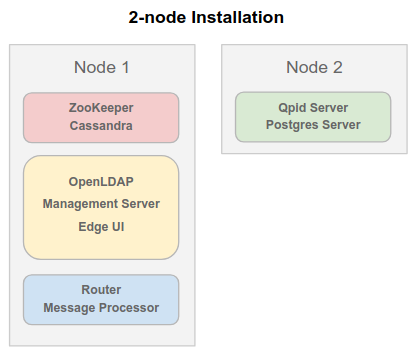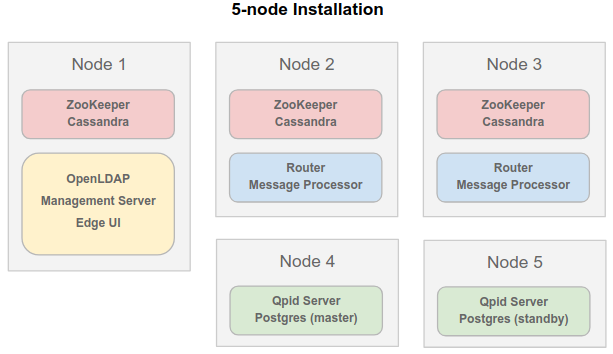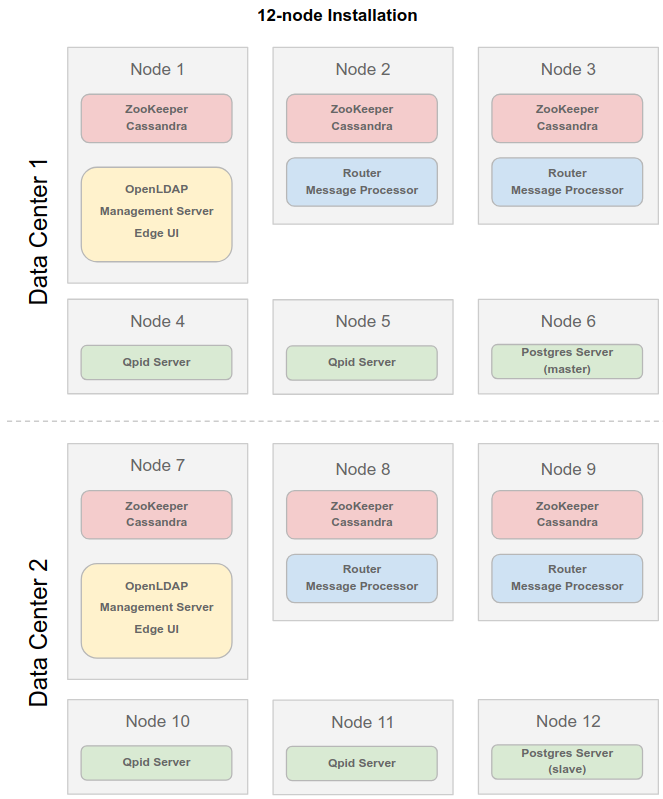Cette section décrit les topologies d'installation Edge (c'est-à-dire les configurations de nœuds compatibles avec Edge).
Le tableau suivant présente les configurations* :
| Topologie | Nœuds | Instructions d'installation |
|---|---|---|
| Topologies hors production | ||
| Tout-en-un (1 nœud) |
|
Installation tout-en-un |
| 2 nœuds (autonome) |
|
Installation autonome à deux nœuds |
| 5 nœuds |
|
Installation à cinq nœuds |
| Topologies de production | ||
| Centre de données unique (9 ou 13 nœuds par centre de données) | ||
| 9 nœuds |
|
Installation en cluster à neuf nœuds |
| 13 nœuds |
|
Installation en cluster à 13 nœuds |
| Plusieurs centres de données (6 nœuds par centre de données) | ||
| 12 nœuds | Deux centres de données, chacun comportant six nœuds, chacun composé des éléments suivants :
|
Installation en cluster à 12 nœuds |
| * Ces configurations n'incluent pas le portail Apigee Developer Services (ou simplement le portail). Pour en savoir plus, consultez Présentation du portail. | ||
Pour Apigee Edge pour le cloud privé, afin de planifier les exigences de topologie personnalisée, veuillez contacter votre représentant commercial ou votre responsable de compte pour faire appel aux services professionnels et à l'équipe chargée de la réussite des clients Apigee Edge. Les performances varient selon le cas d'utilisation. Nous vous recommandons donc de configurer un environnement de performances pour analyser et ajuster vos performances avant de déployer les modifications dans votre environnement de production.
Installation tout-en-un (un nœud)
Un seul nœud exécute tous les composants Edge.

Les vidéos suivantes vous présentent les exigences et la procédure d'installation d'Edge sur un seul nœud :
S26E07 : Exigences concernant l'installation
S26E08 : Installer sur un nœud unique
Remarques supplémentaires :
- Apigee recommande d'utiliser cette topologie uniquement pour les installations hors production ou de développement, car cette configuration n'est pas optimale pour les performances.
- Cette topologie ne doit pas être utilisée pour les tests de performances.
- Cette topologie n'est pas compatible avec la haute disponibilité.
- Vous ne pouvez pas installer les services de monétisation sur une configuration AIO.
Pour en savoir plus sur l'installation, consultez Installation tout-en-un.
Installation autonome (deux nœuds)
Dans ce scénario, un seul nœud exécute des serveurs de passerelle autonomes et les composants associés : serveur de gestion Apigee, Apache ZooKeeper, Apache Cassandra, SymasLDAP, interface utilisateur Edge, routeur Apigee et processeur de messages Apigee. L'autre nœud exécute les composants autonomes Analytics : le serveur Qpid et le serveur Postgres.

Remarques supplémentaires :
- Apigee recommande d'utiliser cette topologie uniquement pour les installations hors production ou de développement, car cette configuration n'est pas optimale pour les performances.
- Cette topologie ne doit pas être utilisée pour les tests de performances.
- Cette topologie n'est pas compatible avec la haute disponibilité.
Pour en savoir plus sur l'installation, consultez Installation autonome à deux nœuds.
Installation en cluster à cinq nœuds
Dans une topologie à cinq nœuds, trois nœuds exécutent les clusters ZooKeeper et Cassandra. L'un de ces trois nœuds exécute également le serveur de gestion Apigee, SymasLDAP et l'UI Edge. Deux de ces trois nœuds exécutent également le routeur et le processeur de messages Apigee. Deux nœuds exécutent Apigee Analytics.

Remarques supplémentaires :
- Apigee recommande d'utiliser cette topologie uniquement pour les installations hors production ou de développement, car cette configuration n'est pas optimale pour les performances.
- Cette topologie limite la capacité à faire évoluer le déploiement pour répondre aux futurs besoins d'expansion. Seuls les routeurs et les processeurs de messages peuvent être facilement développés dans cette topologie, comme décrit dans Ajouter un nœud de routeur ou de processeur de messages. Pour développer cette topologie, vous adoptez généralement l'une des topologies plus importantes décrites dans cette section.
- Cette topologie ne doit pas être utilisée pour les tests de performances.
- Cette topologie n'est pas compatible avec la haute disponibilité.
Pour en savoir plus sur l'installation, consultez Installation à cinq nœuds.
Installation en cluster à neuf nœuds
Ce scénario est semblable à l'installation en cluster à cinq nœuds, mais la configuration des composants Analytics est différente pour obtenir des performances de haute disponibilité.

Remarques supplémentaires :
- Bien que cette topologie représente le nombre minimal de nœuds pour une installation de production, elle n'est pas optimale en termes de performances.
- Vous pouvez étendre cette topologie pour prendre en charge la haute disponibilité, comme décrit dans Ajouter un centre de données.
- Dans cette topologie, les routeurs et les processeurs de messages sont hébergés sur les mêmes nœuds, ce qui peut entraîner des problèmes de "voisin bruyant".
- Cette topologie est limitée à une configuration Cassandra à trois nœuds avec un quorum de deux. Par conséquent, votre capacité à mettre un nœud hors service pour maintenance est limitée.
Pour en savoir plus sur l'installation, consultez Installation en cluster à neuf nœuds.
Installation en cluster à 13 nœuds
Ce scénario est une amélioration de l'installation en cluster à neuf nœuds, qui couvre les zones de données distinctes pour les serveurs de données et Apigee dans une configuration à un seul centre de données. Ici, LDAP est installé en tant que nœud distinct indépendant.

Remarques supplémentaires :
- Apigee recommande cette configuration comme topologie minimale pour les configurations de production avec les caractéristiques matérielles documentées. Pour en savoir plus, consultez Configuration matérielle requise.
- Vous pouvez étendre cette topologie pour assurer la haute disponibilité dans plusieurs centres de données, comme décrit dans Ajouter un centre de données.
- Dans cette topologie, les routeurs et les processeurs de messages sont hébergés sur les mêmes nœuds, ce qui peut entraîner des problèmes de "voisin bruyant".
- Cette topologie est limitée à un anneau Cassandra à trois nœuds avec un quorum de deux. Par conséquent, votre capacité à mettre un nœud hors service pour maintenance est limitée.
Pour en savoir plus sur l'installation, consultez Installation en cluster à 13 nœuds.
Installation en cluster à 12 nœuds
Ce scénario couvre la reprise après sinistre et la haute disponibilité des analyses dans deux centres de données.

Remarques supplémentaires :
- Apigee considère que cette topologie est adaptée à la production. Toutefois, comme chaque installation a ses propres exigences et défis, veuillez contacter votre représentant commercial ou votre responsable de compte pour faire appel aux services professionnels et au service client Apigee Edge.
- Dans cette topologie, les routeurs et les processeurs de messages sont hébergés sur les mêmes nœuds, ce qui peut entraîner des problèmes de "voisin bruyant".
Pour obtenir des informations sur l'installation, consultez Installation en cluster à 12 nœuds.
Installer les services de monétisation
Les services de monétisation s'exécutent dans toute configuration Apigee Edge existante, à l'exception de la configuration tout-en-un (AiO).
Pour installer la monétisation, vous devez installer les services de monétisation, le serveur de gestion Apigee et le processeur de messages. Pour installer la monétisation sur Edge lorsque l'installation Edge comporte plusieurs nœuds Postgres, ces nœuds doivent être configurés en mode maître/veille. Vous ne pouvez pas installer la monétisation sur Edge si vous avez plusieurs nœuds maîtres Postgres.
Pour en savoir plus, consultez Installer les services de monétisation.

